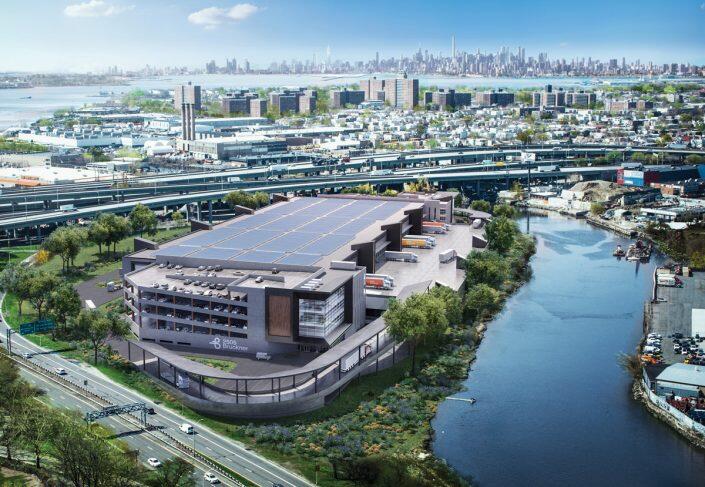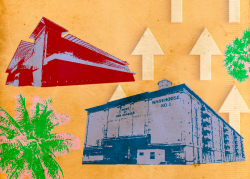There was nowhere to go but up.
In 2016, Dov Hertz, the No. 2 person at Gary Barnett’s Extell Development, made a late-career leap and started his own shop. He decided to focus on industrial, though as a New York City developer he had no experience with it: New Jersey’s sprawling industrial parks, comprising some 800 million square feet, had long served as the city’s warehouses.
But there was talk about shortening delivery times, and the traffic-choked truck routes across the Hudson River weren’t getting any less crowded.
“The handwriting on the wall was that industrial tenants were going to have to come into the boroughs,” Hertz said.
Seemingly overnight, industrial tenants needed sophisticated operations in the city, but prospects were few. Less than 3 percent of it is zoned for industrial use, and the little industrial space it does have isn’t state-of-the-art. Former manufacturing hubs like Dumbo had long ago become pricey residential enclaves.
Rezoning plots for industrial use requires a near-impossible political consensus, Hertz said. And putting single-story warehouses on the available sites would not provide enough square footage to pencil out. Anyone seeking to capitalize on the trend toward same-day and next-day delivery — which the pandemic only accelerated — would have to build vertically.
Testing ground
Multi-level industrial is an established field in Asia but entirely new in North America. Industry leaders say it is in the early stages of a long growth trend.
In urban areas, this warehouse space can fetch three times the rents per square foot of its single-story, suburban counterpart — a reward that justifies the high property and redevelopment costs, which includes adding truck ramps to upper floors, they say.
“The case for multi-story warehousing and urban redevelopment will strengthen alongside rents, as it addresses both the aging of existing urban product and the scarcity and high cost of land,” Prologis, the dominant industrial REIT, said in a report.
In 2018, San Francisco–based Prologis developed the first multi-level industrial building in the U.S., a three-story structure in south Seattle. But in the past couple of years, New York City has become the product’s main North American testing ground, with a few adventurous developers including Hertz’s DH Property Holdings, Scott Rechler’s RXR Realty and Andrew Chung’s Innovo Property Group leading the way.

Their first multi-level industrial projects in the city are still under construction. Innovo’s 2505 Bruckner, slated for completion in 2022, is now in the lease-up phase. It is only two stories, but its formidable size, sleek exterior and coiled ramps hint at the shape of urban industrial development to come.
Roughly five years ago, when Chung was scouting the Bronx site — a tight, triangular plot at the intersection of the Cross Bronx and Bruckner expressways and the Hutchinson River Parkway — the value proposition wasn’t obvious. And because Chung lacked a long track record of developing industrial warehousing, he asked JLL to evaluate the project’s feasibility.
Rob Kossar, head of JLL’s Northeast industrial unit, recalled experiencing an epiphany. “It was while we were looking at that property that we realized there was going to be a huge market,” he said.
Kossar flew to Asia and spent weeks checking out multi-level industrial properties in China, Japan and Singapore. “We would tell people that it was going to happen” in the U.S., Kossar said. “And other than maybe Dov and Andrew and their investors, nobody else believed us. Everybody believes us now.”
A tight race
There is potential for as much as 20 million square feet of multi-level industrial in New York City, said Kossar, who described the market now as developers racing for a foothold.
Multi-level properties can fetch rents as high as $40 annually per square foot, he said.
“I think the rents are actually low compared to where they’re going to be, because you’re going to have continued demand as e-commerce grows,” Kossar said. “The supply is finite, this is a very mature city and industrial is not perceived as the highest and best use very often. I think the properties will pay huge dividends in the future.”
Industrial developers in the city have recently adopted a demographic-focused mindset akin to a retail developer’s: Proximity to the consumer is everything, said Goran Brelih, senior vice president at Cushman & Wakefield.
“It’s all about the end user being close to a certain density of population and density of income, and they will pay the high rent that is required for a developer to make a certain return,” Brelih said.
DH Property Holdings’ three-story development at 640 Columbia Street in Red Hook, Brooklyn, now leased to Amazon’s logistics arm, AMZL, is generally considered the first multi-story industrial building on the East Coast.

The firm, in partnership with Bridge Development Partners and Banner Oak Capital Partners, is also redeveloping the 18-acre Sunset Industrial Park in Brooklyn’s Sunset Park, which will have multiple multi-story distribution facilities upon completion.
RXR and LBA Logistics together are developing a 1.1 million-square-foot, five-story logistics center at 55-15 Grand Avenue in Maspeth, Queens — the city’s tallest logistics facility so far. RXR’s website says it will be “a fully customizable industrial complex primed for the innovation economy.”
Industrial buildings in Hong Kong are as high as 27 stories, but U.S. properties are unlikely to surpass five or six floors in the near term, according to Michael Bennett, head of development at DH Property Group. Trucks are much longer in the U.S. than in Asia, so the helical access ramps have to be wider.
Once autonomous delivery trucks become the norm in the U.S., industrial properties theoretically could go much higher, Bennett said.
Other markets
The New York City industrial market’s renaissance as a hyper-modern, multi-level asset class is a given, and ultimately it will service a range of tenants, including cold storage and other industrial users, Rebecca D’Eloia, senior vice president at RXR Realty, said.
“Given the limited amount of available land, combined with this increased demand, multi-level industrial facilities are ultimately inevitable in a place like New York City,” D’Eloia said.
In other cities, too. D’Eloia and other industry leaders foresee multi-level industrial in many major metros in the U.S. and Canada. Properties are in the planning and early development stages in Chicago; Washington, D.C.; San Francisco; Los Angeles; Toronto and Vancouver.
The outlook wasn’t always so favorable. Before the pandemic sent industrial property values through the roof, some doubted multi-story industrial would ever take off in the U.S., given the height requirements and stricter building codes and the higher rents tenants would have to pay. Skeptics still think it is a niche market, and won’t be economical in sprawling urban areas like Los Angeles.
The new developments tend to track high land prices, said Frank Di Roma, a principal at the design firm Mare Walcomb, which has worked on many of the first multi-level industrial projects in North America.
All of the projects in planning or development today are being built on spec, meaning without a tenant commitment, Di Roma said. Planners’ primary concern is flexibility — designing a building to service a variety of tenants and accommodate a range of new technologies, like autonomous trucks and drones, that may transform the market in the coming years.
“They’re focused on the life cycle of the building,” he said. “They want to make sure they can lease it to a variety of uses. They don’t want to get stuck with a building that is only for one type of tenant.”
Given the lack of precedent, the initial projects involve a lot of conjecture. For example, no one knows yet how to value space on a second or third floor, which may be worth more to tenants because it is less prone to theft than street-level floors, Di Roma said.
There is also the matter of the facade, which in a city — as opposed to an isolated suburban area — has to be more dynamic and attractive. That is both a challenge and a branding opportunity, according to Di Roma.
Once one of the early projects is fully leased and in operation, the market will finally have a benchmark.
“Whoever is first out of the gate, they’ll have an advantage, because everybody else is just going to follow suit in terms of construction, in terms of rent rate,” Di Roma said. “It’s really guesswork right now, because nobody really knows.”
Read more


